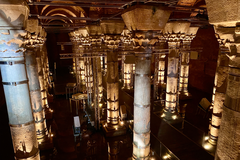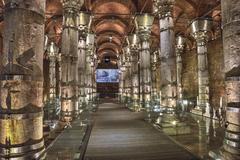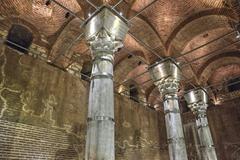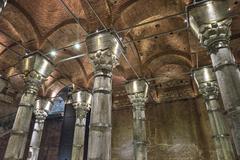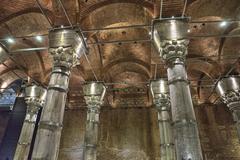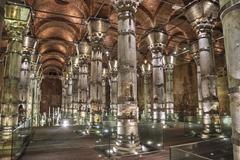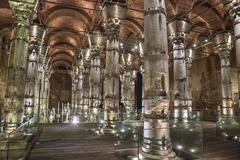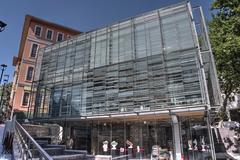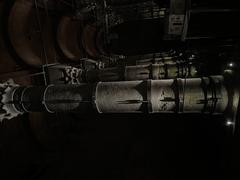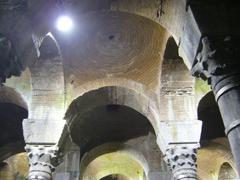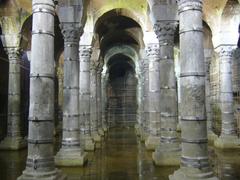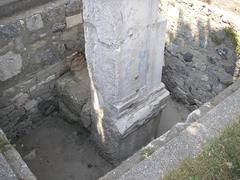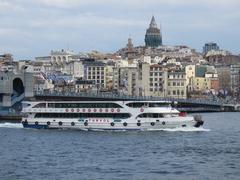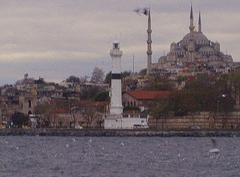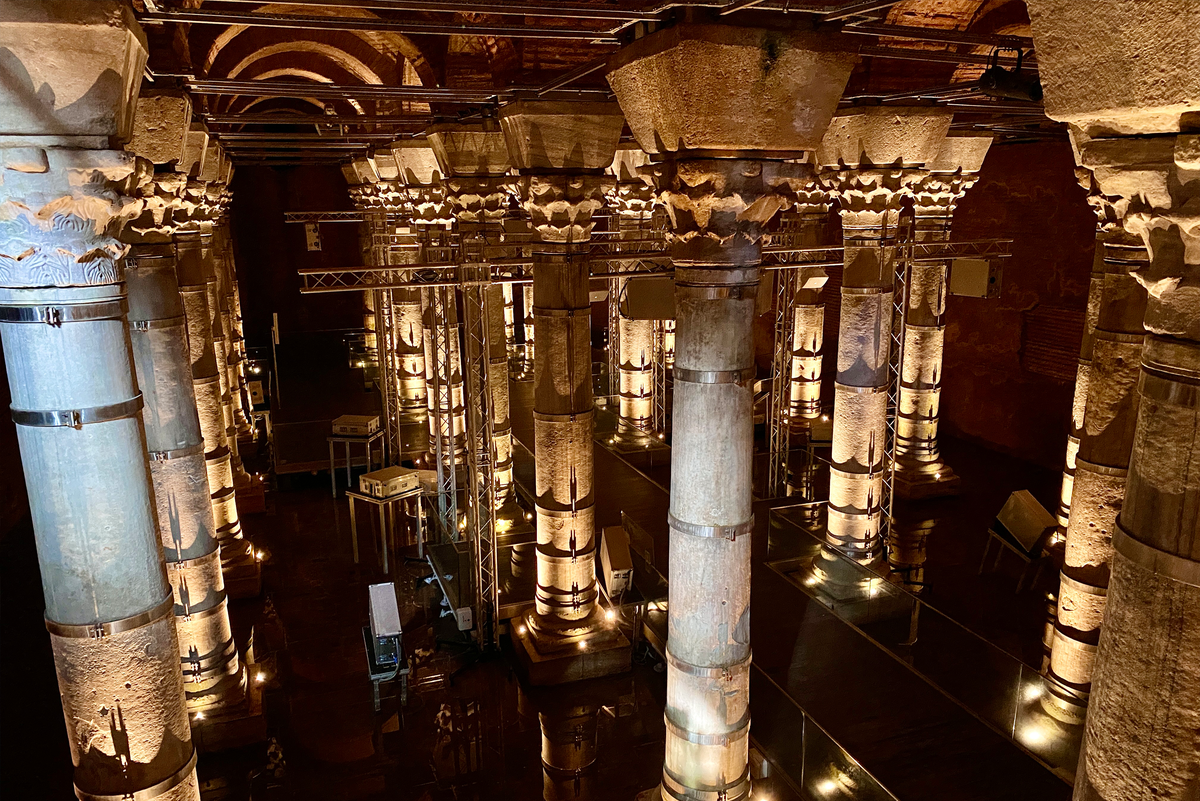
Şerefiye Sarnıcı Visiting Hours, Tickets, and Historical Insights
Date: 18/07/2024
Introduction
The Şerefiye Sarnıcı, also known as the Theodosius Cistern, is one of Istanbul’s hidden gems and a testament to the engineering prowess of the Byzantine era. This ancient underground water reservoir, constructed during the reign of Emperor Theodosius II between 428 and 443 AD, offers a unique glimpse into the past, captivating visitors with its architectural beauty and historical significance. Built as part of a larger infrastructure project that included the Valens Aqueduct, the Şerefiye Sarnıcı was designed to store and supply water to Constantinople, the capital of the Byzantine Empire (Istanbul Metropolitan Municipality). Rediscovered in the early 20th century, the cistern underwent major restoration in the early 2000s, transforming it into a cultural and exhibition space that continues to draw tourists and history enthusiasts alike (Istanbul Archaeological Museums).
Table of Contents
- Introduction
- History of Şerefiye Sarnıcı
- Modern-Day Significance
- Preservation Efforts
- Conclusion
- FAQ
History of Şerefiye Sarnıcı
Origins and Construction
The Şerefiye Sarnıcı was constructed during the reign of Emperor Theodosius II, between 428 and 443 AD. It was built to store and supply water to Constantinople, the capital of the Byzantine Empire. This construction was part of a larger infrastructure project that included the Valens Aqueduct, which brought water from the Belgrade Forest to the city (Istanbul Metropolitan Municipality).
Architectural Features
The cistern measures approximately 45 meters in length, 25 meters in width, and 11 meters in height, with a capacity of around 32,000 cubic meters of water. It is supported by 32 marble columns, each standing 9 meters tall, arranged in 8 rows of 4 columns. The columns are connected by arches, creating a visually stunning and structurally sound design (Istanbul Archaeological Museums).
Historical Significance
The Şerefiye Sarnıcı played a crucial role in the water supply system of ancient Constantinople. Although its significance diminished during the Ottoman period, it remains an important historical site, reflecting the ingenuity of Byzantine engineers (Istanbul Metropolitan Municipality).
Rediscovery and Restoration
Rediscovered in the early 20th century during construction work, the cistern was in a state of disrepair. A major restoration project was undertaken by the Istanbul Metropolitan Municipality in the early 2000s, including cleaning and reinforcing the columns and arches, installing a new lighting system, and creating a visitor-friendly environment (Istanbul Metropolitan Municipality).
Modern-Day Significance
Visitor Experience
Visitors can explore the cistern through walkways and platforms that provide a close-up view of the columns and arches. The cistern is illuminated with a sophisticated lighting system that highlights its architectural features. Information panels and interactive displays provide historical context, and guided tours offer in-depth insights into the history and architecture of the site (Istanbul Metropolitan Municipality).
Visiting Hours and Tickets
The Şerefiye Sarnıcı is open to visitors year-round. Visiting hours typically range from 9:00 AM to 6:00 PM, but it is advisable to check the official website for any changes. Tickets can be purchased on-site or online, with prices varying for adults, students, and groups. Special discounts may be available for children and seniors.
Travel Tips and Nearby Attractions
For those planning a visit, it is recommended to wear comfortable shoes as the cistern involves walking. Nearby attractions include the Basilica Cistern, Hagia Sophia, and the Blue Mosque, making it easy to explore multiple historical sites in one trip. The Şerefiye Sarnıcı is also accessible via public transportation, with several tram and bus stops nearby.
Preservation Efforts
The preservation of the Şerefiye Sarnıcı is an ongoing effort, with regular maintenance and monitoring to ensure its structural integrity. The restoration and preservation efforts have been recognized internationally, receiving several awards for conservation and adaptive reuse (UNESCO World Heritage Centre).
Conclusion
The Şerefiye Sarnıcı is a testament to the engineering and architectural achievements of the Byzantine Empire. Its rediscovery and restoration have brought to light an important piece of Istanbul’s history, offering visitors a unique and immersive experience. The cistern’s transformation into a cultural and exhibition space has ensured its continued relevance and significance in the modern era. As a historical site, the Şerefiye Sarnıcı provides valuable insights into the water supply systems of ancient Constantinople and the ingenuity of its engineers (Istanbul Archaeological Museums).
FAQ
What are the visiting hours for Şerefiye Sarnıcı?
The visiting hours are typically from 9:00 AM to 6:00 PM, but it’s best to check the official website for any updates.
How much are tickets to Şerefiye Sarnıcı?
Ticket prices vary for adults, students, and groups, with discounts available for children and seniors. Tickets can be purchased on-site or online.
What are the best nearby attractions to visit?
Nearby attractions include the Basilica Cistern, Hagia Sophia, and the Blue Mosque, making it convenient to explore multiple historical sites in one visit.
References
- Istanbul Metropolitan Municipality. (n.d.). Retrieved from https://www.ibb.istanbul/
- Istanbul Archaeological Museums. (n.d.). Retrieved from https://muze.gov.tr/muze-detay?SectionId=ISR01&DistId=ISR
- UNESCO World Heritage Centre. (n.d.). Retrieved from https://whc.unesco.org/en/list/356
- TripAdvisor. (n.d.). Retrieved from https://www.tripadvisor.com/Attraction_Review-g293974-d15196700-Reviews-Serefiye_Sarnici-Istanbul.html
